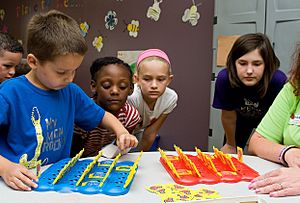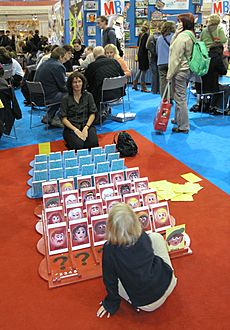Guess Who? facts for kids
Guess Who? is a two-player character guessing game created by Ora and Theo Coster, also known as Theora Design, that was first manufactured by Milton Bradley in 1979 and is now owned by Hasbro. It was first brought to the UK by Jack Barr Sr. in 1982. The classic edition is currently being produced by Winning Moves Games USA.
Gameplay
Each player starts the game with a board that includes cartoon images of 24 people and their first names with all the images standing up. Each player selects a card of their choice from a separate pile of cards containing the same 24 images. The objective of the game is to be the first to determine which card one's opponent has selected. Players alternate asking various yes or no questions to eliminate candidates, such as:
- "Does your person wear a hat?"
- "Does your person wear glasses?"
- "Is your person a man?"
The player will then eliminate candidates (based on the opponent's response) by flipping those images down until only one is left. Well-crafted questions allow players to eliminate one or more possible cards.
Editions
Special editions which have different faces have been released, including Star Wars, Marvel Comics and Disney. There are smaller, "travel" editions which have only 20 different faces. In 2008 and 2010, extra and mix and match games were released. A computer game based on the series was released in 1999 by Hasbro Interactive.
Advertising
In the United States, advertisements for the board game often showed the characters on the cards coming to life, and making witty comments to each other. This caused later editions of such ads to carry the spoken disclaimer line "game cards do not actually talk" in order to meet Federal Trade Commission advertising guidelines requiring full disclosure of toy features unable to be replicated with the actual product.
Strategy
Popular belief is that a binary search is the most efficient approach to the game, where each question halves the number of possible identities. This can be applied by asking complex questions - such as "Does your character have red hair, or glasses, or a big nose?" - where a yes or a no eliminates exactly half of the remaining characters. Such a strategy takes only four questions to reduce the field to three people, giving the fifth question a 50/50 chance of identifying the opponent's character.
The game was strongly solved by Mihai Nica in 2016. Refuting the binary search approach, Nica's research showed higher rates of success for a strategy of making "bold plays" to catch up with the other player. Using this method, the first player has a 63% chance of winning under optimal play by both sides.
People's names
| Name | Also known as | Introduced | Retired | Notes |
|---|---|---|---|---|
| Al | Alfred, Stephen | 1980 | — | |
| Amy | — | 2018 | — | |
| Anita | — | 1980 | 2018 | |
| Anne | — | 1980 | 2018 | Absent from 1998-2002 |
| Ben | — | 2018 | — | |
| Bernard | — | 1980 | 2018 | |
| Betty | — | 1999 | 2001 | |
| Bill | Phillipe | 1980 | 2018 | |
| Carmen | — | 2002 | — | |
| Charles | Hans | 1980 | 2018 | |
| Claire | Sarah | 1980 | 2018 | |
| Daniel | — | 2018 | — | |
| David | Luke, Lucas | 1980 | — | |
| Emma | — | 2018 | — | |
| Eric | — | 1980 | — | |
| Farah | — | 2018 | — | |
| Frank | — | 1980 | 1998 | |
| Gabe | — | 2018 | — | |
| George | Joe | 1980 | 2001 | |
| Herman | — | 1980 | 2018 | |
| Holly | Kaitlin | 1999 | 2018 | |
| Joe | — | 1980 | — | Absent from 1998-2002 |
| Jordan | — | 2018 | — | |
| Katie | — | 2018 | — | |
| Laura | — | 2018 | — | |
| Leo | — | 2018 | — | |
| Lily | — | 2018 | — | |
| Liz | — | 2018 | — | |
| Maria | — | 1980 | 2018 | |
| Max | Theo | 1980 | 2018 | |
| Mia | — | 2018 | — | |
| Mike | — | 2018 | — | |
| Nick | — | 2018 | — | |
| Olivia | — | 2018 | — | |
| Paul | — | 1980 | 2018 | |
| Peter | — | 1980 | 2018 | Absent from 1998-2002 |
| Philip | Max, Mario | 1980 | 2018 | |
| Rachel | — | 2018 | — | |
| Richard | Roger | 1980 | 2018 | |
| Robert | — | 1980 | 1999 | |
| Sally | Sophie | 1999 | 2018 | |
| Sam | Charles | 1980 | — | |
| Sofia | — | 2018 | — | |
| Susan | — | 1980 | 1998 | |
| Tom | Albert, Daniel | 1980 | 2018 | |
| Victor | — | 1999 | 2018 |
See also
 In Spanish: Guess Who? para niños
In Spanish: Guess Who? para niños



